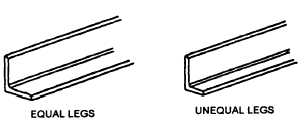Figure 1-34.—Angles.
Figure 1-35.—Built-up column section.
web and the weight, in pounds, per foot of length. A
W14 x 30, for example, indicates a W-shape that is 14
inches deep along its web and weighs 30 pounds per
linear foot. Hence a 20-foot length of this size W-shape
would weigh a total of 600 pounds.
The bearing pile, HP-shape, is almost identical to
the W-shape. The only difference is the thickness of the
web and flange. In the bearing pile, the web and flange
thickness are equal, whereas the W-shape has unequal
web and flange thickness.
An angle is a structural shape whose cross section
resembles the letter L. As pictured in figure 1-34, angles
are available with either equal or unequal legs. The
dimension and thickness of its legs are used to identify
an angle; for example, L6 x 4 x 1/2. The dimension of
each leg is measured along the outside of the angle, and
for unequal-leg angles, the dimension of the wider leg
is always given first, as in the example just cited. The
third dimension applies to the thickness of the legs,
which always have equal thickness. Angles are used
primarily to support, brace, or connect other structural
members. They may be used as single members, or they
may be used in combinations of two or four to form main
members.
Steel plate is a structural member that has a width
greater than 8 inches and a thickness of 1/4 inch or more.
Plates are generally used as connections between other
structural members. They may also be used as
Figure 1-36.—Weight and thickness of steel plate.
Figure 1-37.—Bars.
component parts of built-up structural members, such as
the built-up column shown in figure 1-35. Plates cut to
specific sizes may be obtained in widths ranging from
8 inches to 120 inches or more and in various
thicknesses.
Plates are identified by their thickness, width, and
length, all measured in inches; for example, PL
1/2 x 18 x 30. Sometimes, you may also hear plate
referred to by its approximate weight per square foot for
a specified thickness. As shown in figure 1-36, 1 cubic
foot of steel weighs 490 pounds. This weight divided by
12 gives you 40.8 pounds, which is the weight of a steel
plate measuring 1 foot square and 1 inch thick. By
dropping the fractional portion, a 1-inch plate is called
a 40-pound plate; and, with similar reasoning, a 1/2-inch
plate is called a 20-pound plate.
The structural shape referred to a bar has a width
of 8 inches or less and a thickness greater than 3/16 inch.
The edges of bars usually are rolled square, like
universal mill plates. The dimensions are expressed in
a similar manner as that for plates; for instance, bar
6 x 1/2. Bars are available in a variety of cross-sectional
shapes-round, hexagonal, octagonal, square, and flat.
Three different shapes are shown in figure 1-37. Both
squares and rounds are commonly used as bracing
members of light structures. Their dimensions, in
1-18








